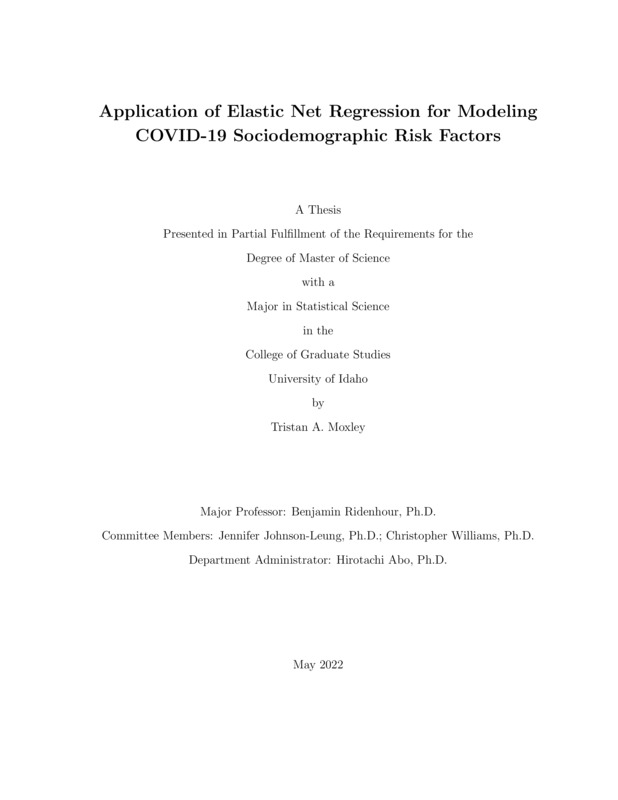Application of Elastic Net Regression for Modeling COVID-19 Sociodemographic Risk Factors
Moxley, Tristan A.. (2022-05). Application of Elastic Net Regression for Modeling COVID-19 Sociodemographic Risk Factors. Theses and Dissertations Collection, University of Idaho Library Digital Collections. https://www.lib.uidaho.edu/digital/etd/items/moxley_idaho_0089n_12399.html
- Title:
- Application of Elastic Net Regression for Modeling COVID-19 Sociodemographic Risk Factors
- Author:
- Moxley, Tristan A.
- ORCID:
- 0000-0002-8259-808X
- Date:
- 2022-05
- Keywords:
- COVID-19 Elastic net regression Regularization Risk modeling Sociodemographic risk
- Program:
- Mathematics & Statistical Sci
- Subject Category:
- Statistics
- Abstract:
-
COVID-19 has been at the forefront of global concern since its emergence in Decemberof 2019. Determining the social factors that drive case incidence is paramount to mitigating disease spread. Simple predictive analysis in the form of multiple regression proves to be an inefficient method for predicting COVID-19 case rate using sociodemographic factors, as many of these factors are collinear; additionally, multiple regression is insufficient as this technique results in models that overfit the data, meaning the models cannot generalize when given new data and thus perform poorly. As such, biased estimation through elastic net regression was used to conduct a broad-based analysis across the ten HHS health regions for both the pre-Delta (March 22, 2020 to June 15, 2021) and Delta (June 15, 2021 to November 1, 2021) waves of the COVID-19 pandemic. Statistically, elastic net proved to be much more accurate in its prediction when compared to multiple regression, as almost every HHS model consistently had a lower root mean square error (RMSE); additionally, these models also succeeded in remedying overfitting through verification by way of training/testing R2 evaluation. From an epidemiological standpoint, this research confirmed many of the known trends in terms of social factors that influence case incidence (such as group quarters percentage or mobile home percentage per county), while also discovering interesting trends occurring across different waves of the pandemic that give insight into the effect of measures such as vaccination. This research provides a novel approach to modeling sociodemographic risk factors against COVID-19 case rate which can easily be expanded upon in the future with a more robust set of sociodemographic factors.
- Description:
- masters, M.S., Mathematics & Statistical Sci -- University of Idaho - College of Graduate Studies, 2022-05
- Major Professor:
- Ridenhour, Benjamin
- Committee:
- Johnson-Leung, Jennifer; Williams, Christopher; Abo, Hirotachi
- Defense Date:
- 2022-05
- Identifier:
- Moxley_idaho_0089N_12399
- Type:
- Text
- Format Original:
- Format:
- application/pdf
- Rights:
- In Copyright - Educational Use Permitted. For more information, please contact University of Idaho Library Special Collections and Archives Department at libspec@uidaho.edu.
- Standardized Rights:
- http://rightsstatements.org/vocab/InC-EDU/1.0/

